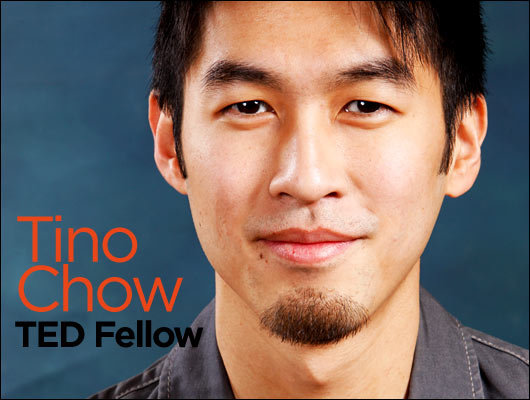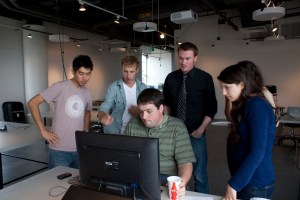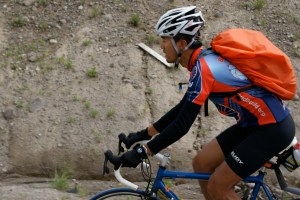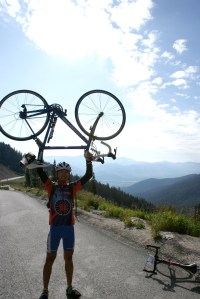What do you devote most of your time to?
Everything I do is based on what I believe in: making the world a better place, using my skills as a designer and a community organizer. The company I started about a year and a half ago, called Big New Ideas, is kind of my official channel of doing that. We are a storytelling, community-building design studio. We specialize in helping people with Big New Ideas communicate what that idea is. We look for businesses and non-profits that are trying to make the world a better place. And we help them learn to build a community around their idea. Because without the community, without people believing in it, it really doesn’t matter how good the idea is.
How is Big New Ideas run?
My two partners and I spend about 60% of our time doing revenue-producing client work so we can eat and survive. We spend about 40% of our time making our own ideas happen: a “24 Hour Design Jam,” a cross-country bike trip, a design meet-up in New York City. We’re trying to build our own communities and ask our own questions.
On the side, I do a lot of different projects to help other non-profits that don’t have the resources to hire us yet. For example, the 24 Hour Design Jam gives an opportunity for designers and creatives to come together, and work on some projects that benefit our local community.
The 24 Hour Design Jam sounds like a lot of fun! Tell us about that.
It’s a gathering of a group of six or seven local designers and creatives, coming together to help a local non-profit within twenty-four hours over a weekend.
It solves a couple issues on several levels. Firstly, that in this day and age it’s really hard to find time to volunteer. Volunteering for a couple hours a week over a couple months is not ideal because people have different commitments, and people lose interest or … you know, things happen. This whole idea is to condense the period over Friday and Saturday, so it’s not a huge commitment, but a manageable one.
Another issue it addresses is: we designers don’t always have an outlet to use our skills to help non-profits. A lot of times non-profits require certain things to help with their organization, and design is not one of them. But non-profits frequently do need help telling their story and building community, via their website.
Lastly, when we do pool these creative people together, it tends to eliminate individual egos. In a normal design world, where you have more time, mostly designers will have fights about whose design is better, and why their design should be picked. In a short 24-hour period, we have a nice, distinct goal: to build a website quickly. People are more willing to put down their ego, and work together. We bring all these local creatives together, and everybody, at the end of the day, has fun.
The idea is to have the 24 Hour Design Jam once a month, with a local non-profit. And hopefully, in the next few months, we’ll be discovering how to make this work better. Then we’ll package it so that anyone, in any city, can pick this idea up and do it for their local non-profit, by gathering their local talent.
What about the cross-country bike trip you mentioned? Why did you do that?
I did that last summer with Bike and Build. Every year they have about 250 young people ride across the country, and on the way, help build houses. To qualify for the trip, every person has to raise $4,000. Instead of asking family and friends, I went to corporate companies and strategically asked for money.
I ended up with a couple of interesting partners. One was BeDo, which is all about being and doing what you believe in. One of the other partnerships was with Yahoo. They gave me a camera phone that took a photo every minute along the way. They sent them out to Flikr, so I have a trail of photos from the East Coast to the West Coast. They are all geotagged, so you can tell where each photo was taken.
As part of being a storyteller, I wanted to capture not just what I was doing with Habitat for Humanity, but what I really saw, what I was doing in real time as well. I did a lot of blogging along the trip. I made thirty or forty videos along the way, and I have this trail of photos that shows where I was. It shows different terrain, and even the weather that was going through. So the partnerships really helped me tell my story, and reach out to the audience we wanted to reach out to. They also helped me challenge other young people to work for what they really believe in, to change the world.
What did you learn from the experience?
I think I learned a lot of things. I was born in Singapore, grew up in Hong Kong, and moved to the U.S. in 2005. Not coming from the U.S., it was a very interesting opportunity for me. All I knew of America were the big cities all along the coast. I had never been into the middle of the country. In Iowa for days on end, we didn’t see anything but cornfields. I learned that none of the corn was to eat — it was all being grown for energy or corn syrup. It really struck me how industrialized the culture has become. It’s becoming more and more irrelevant where our food is coming from, and I do really care about that.
Secondly, interacting with people in the middle of the country is also really different. They are a lot friendlier than I originally thought. They’re a lot more open to hearing what we’re doing, what we believe in. When we were building houses, frequently people would show up and give us free food or other things.
I wanted to learn about affordable housing issues. The interesting thing about America is, it’s a rather wealthy country. But when I visited these small towns, it became more and more apparent that the country is a lot poorer than I originally thought. A lot of people don’t have livable houses, and sometimes don’t even have water. That really struck me. It opened my eyes to how deep these problems run in America. I do care about all these issues, and it gave me a chance to tell these stories, and spread the word on the depths of the problem.
What about the other 60% of time at Big New Ideas, used to make ends meet?
At the end of the day, all the work we do points in the same direction: trying to make the world a better place. A lot of what we do is storytelling and community-building. We do a lot of social media, website design, graphic design — it just kind of happens that that is all a result of telling a story and community building.
A client of ours called PeaceLove is a foundation and a for-profit in one. Their business is trying to build a positive symbol for mental health, in the same way the pink ribbon is to breast cancer, or that project (RED) is to AIDS.
One in four adults in America are diagnosed with some kind of mental illness, so either you have it, or you are affected by it. Maybe your friend has it, your family member has it, or someone you work with has it. But at the same time, socially it’s not very accepted yet. Nobody knows how to talk about it, even though it’s so prevalent. This company wants to build this brand, and they need to tell their story well. And they need to build a community of advocates to go out there and start breaking down the stigma. That community can help people comfortably talk about mental illness, and help people know how to react when they hear about it.
PeaceLove is an example of why we started Big New Ideas. We wanted to be part of something that’s bigger than ourselves. We don’t want to just design something pretty that doesn’t really mean anything. We want to be making a difference.
There are many aspiring social entrepreneurs out there who are trying to take their passion and ideas to the next level. What is one piece of advice you would give to them based on your own experiences and successes?
Learn more about how to become a great social entrepreneur from all of the TED Fellows on the Case Foundation blog.
They can hire Big New Ideas. [Laughs] Just kidding.
For me, it’s important not just to look at what we do and how we do it, but to ask that most important question of why we do what we do.
Why we do what we do will always drive what we do and how we do it.
Especially for social entrepreneurs, if they don’t understand why they do what they do, they just have missed the point. That’s my advice and statement that I want to make: understand why you do what you do.
How did your TED experience impact you or your work?
The TED Conference I went to in 2009 was the first time I was put at a level where I felt my good ideas were really understood. For the first time I felt there were other people at the same level, there are people who would support me, and there are people who would give me the opportunity to do what I believe in.
I did make those connections and I did start my company and pursued my passion. I think in a nutshell that’s the impact it made in my life. Without having gone to TED, getting to where I am right now would have taken quite a few more years.
You’ve said you’re a terrible speller. Do you have any embarrassing stories to prove it?
[Laughs] Actually yeah, I do. It happened to me while I was at TEDxEast as I was tweeting on my iPhone. I’m a bad speller to begin with, and on the iPhone it’s a little hard to type, so these two things combined … I tweeted out that this guy was rapping about something really cool, and I missed a ‘p’ on rapping. And once you hit “send” you cannot retract it. And my Twitter account is connected to my Facebook account. I got a lot of comments saying “Do you mean rapping?” Or just “LOL.” That was really bad.
What does the future look like for you?
I don’t see myself doing anything different in the future. I am living my dream, other than the fact that I would like to make a couple more bucks. Other than that, I know that this is what I want to do. I took that leap of faith not to get a job, not to work for somebody, but to create my own job and to create my own company.
And it has been tough. I think we’re very much in a “bootstrap” mode still. But in the last couple months, potential clients have started coming to us for the reasons that we want them to come to us. And they are beginning to understand the importance of storytelling, and the importance of building community. They are coming to us for that specific reason. A lot of the companies that are coming to us are the companies we want to work with. They do see the bigger picture, and they do want to make the world a better place. And they do feel part of it.
So I think more and more, we are going to have these opportunities to work with these kinds of companies. I can see myself doing this forever. It’s exciting for me because I like to work with different people. Every project has its own challenges and its own opportunities to do something different.
With 60% of my time working for clients and 40% of our time working basically for ourselves, I have the opportunity and the creative freedom to do whatever I want to do. And a lot of the things I’m doing are really starting to take off — the monthly meetings in New York, the 24 Hour Design Jam. All this stuff we do really enriches our work for our clients as well. In a way, everything really ties together, and I don’t see myself doing anything else in the future.




Comments (1)